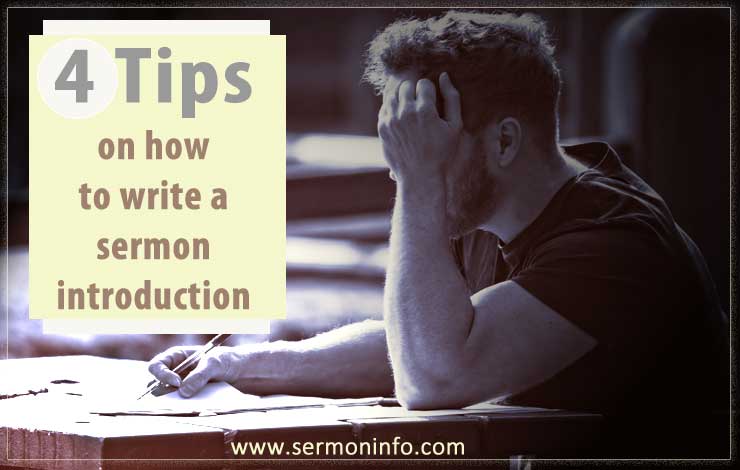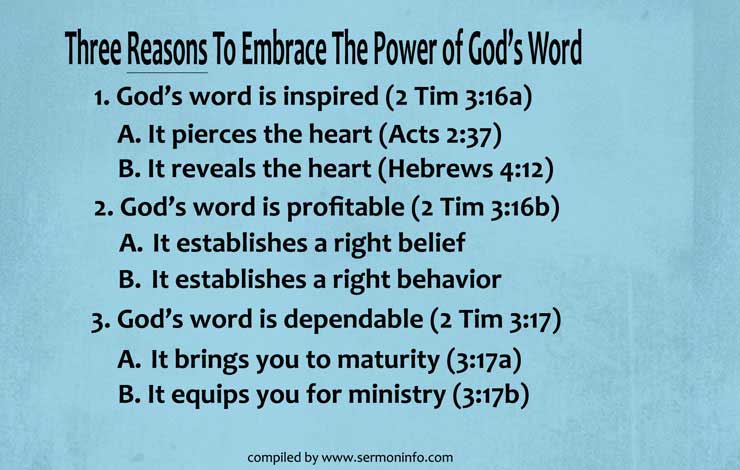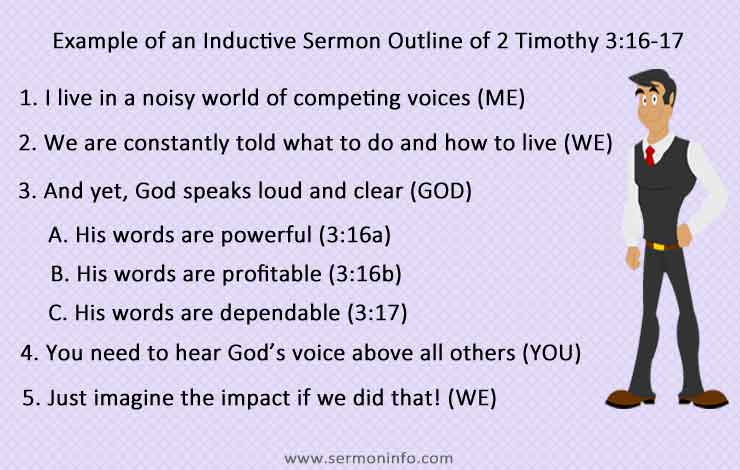I find the students that write the best sermon introductions are the ones who understand the structure of the sermon. This article will look at the structure of the sermon and the four tips for writing a good sermon introduction.
The 4 tips on how to write a sermon introduction are: 1) the introduction must demand attention, 2) the introduction must uncover needs, 3) the introduction must introduce the body of the sermon, and 4) the introduction may have other characteristics.

4 Tips For Writing A Sermon Introduction
- It must command attention
- It must uncover needs
- It must introduce the body of the sermon
- It may have other characteristics
How To Write a Sermon Introduction
Before I look at the four tips for writing a good sermon introduction, I want to quickly note the three parts of the sermon.
The first part is the introduction. The introduction introduces the topic of the sermon or the main preaching point of the sermon.
The second part is the body of the sermon. The body of the sermon is made up of the topic or the main preaching point. The bulk of the sermon comes from the body of the sermon. The body of the sermon is also the sermon outline. See image below.

The third part of the sermon is the conclusion. The conclusion concludes the sermon with a call to action.
When you understand the three parts of the sermon, you will find it much easier to write the introduction and the conclusion.
However, there are different ways to outline a sermon. To keep it super simple, I encourage students to use either the deductive method of sermon outlining (see image above) or the inductive method of sermon outlining (see image below).

From the two examples of the sermon outlines that I have given from 2 Timothy 3:16-17, you will discover that there will be two different introductions.
With the deductive sermon outline, the introduction will introduce the topic, embracing the power of God’s word.
With the inductive sermon outline, the introduction will form around the idea that we live in a noisy world with competing voices.
You can now see why it is important to understand the structure of the sermon. Once you have the structure of the sermon before you, you can easily write a good sermon introduction and conclusion.
Four Tips For Writing a Good Sermon Introduction
In his book Thirty Minutes To Raise The Dead, (Amazon Books) Bill Bennett states that a good introduction arouses the audience’s interest and whets their appetite to hear the message of God.
Hopefully, these four tips will assist you in writing good sermon introductions so that you can arouse your audience’s interest and whet their appetite to hear your message from God.
1. The Introduction Must Command Attention
We do live in noisy world and to get someone’s attention, preachers need to be creative in preparing the introduction to their weekly sermons.
To capture the audience’s attention and to get them to listen to the sermon, you may use the following avenues.
A. Start with a story
I have found story to be a great way of getting people’s attention in order to force them to listen to the sermon. The story should be long enough to introduce the main preaching point of the sermon.
Haddon Robinson solemnly declares that if the preacher does not capture attention in the first thirty seconds, he may never gain it at all.
Here is an example of a story that grabs people attention and highlights the main preaching point of the sermon.
There’s a story about a company that owned a fancy machine that broken down and they couldn’t fix it. They called the company mechanic but he couldn’t fix it. So they had to shut down the business. Finally, they called an expert from out-of-town. It was his specialty. He looked at the machine for a while. He got out a hammer and gave it a bang. The machine worked and the business resumed as usual. The expert gave the company the bill – $1000. The owner was livid so he asked for the bill to be itemized. So the expert itemized the bill as follows: $1.00 for hitting the machine and $999 for knowing where to hit the machine.
You know, I could bang on your heart’s door all day long but the word of God knows exactly what you need. God has this uncanny ability of speaking to our needs through his word. He can touch our hearts like no other through his word because it is inspired. It cuts to the heart and reveals the heart. It is profitable because it establishes our faith and behavior. It is dependable because it brings us to maturity and equips us for ministry. Therefore, I want to discuss in depth the three reasons why we need to embrace the power of God’s word.
B. Start with a paradoxical statement
A paradoxical statement creates tension and it upsets the equilibrium. Therefore, the paradoxical statement grabs people’s attention.
For example, you may start a message with the following statement: “I know that God is in control but the world seems to be falling apart.” Most people will relate to that statement. You now have their attention.
You may start with the following statement: I live in a noisy world with many competing voices. Most people would relate to that statement. You now have their attention.
This is where you need to be creative. It may take some time to craft a statement that grabs their attention.
C. Start with a rhetorical question
Again, you will need to be creative when it comes to grabbing people’s attention with a rhetorical question.
You may write something like this: “if no one cares for you, would you be alone?” This question will make people think about your question. You now have their attention.
D. Start with a startling fact or statistic
This will require some research but it is well worth the time. I started a Christmas message with the following statistic: “We will spend over $1 trillion over the Christmas holidays. What does that say about us as a nation?” You now have their attention.
When you craft the sermon introduction, you must grab the audience’s attention so that they will listen to the sermon or the message God has for them.
2. The Introduction Must Uncover Needs
Uncovering needs will motivate the audience to listen to the sermon. You have their attention; now you need to motivate them to listen to the rest of the sermon.
The Rev. Charles Swindoll started a sermon (For Those Who Hurt) with the following story to motivate his audience to listen to a message from 2 Corinthians 1:3-11.
”El Tablazo looked so close. Too close. It happened so fast. Exploding into the jagged 14,000-foot peak, the DC-4 disintegrated with a metallic scream. What was left of the Avianca Airline flight bound for Quito, Ecuador, flamed crazily down the mountainside into a deep ravine. One awful moment illuminated a cold Colombian mountain in the night, then the darkness returned. And the silence!
Before leaving the airport earlier that day, a young New Yorker named Glenn Chambers hurriedly scribbled a note on a piece of paper he hound on the floor of the terminal. The scrap was part of a printed advertisement with a single word, ‘Why?’ sprawled across the center.
Needing stationery in a hurry, Chambers scrawled a note to his mother around the word in the middle. Quickly holding this last minute thought, he stuffed it in an envelope and dropped it in a post box. There would be more to come, of course. More about the budding of a lifelong dream to begin a ministry with the ‘Voice of the Andes’ in Ecuador.
But there was no more to come. Between the mailing and the delivery of Chambers’ note, El Tablazo snagged his flight and his dreams from the night sky. The envelope arrived later than the news of his death. When his mother received it, the question burned up at her from the page – Why?
It is the question that hits first and lingers longest. Why? Why me? Why not? Why this?” (Taken from Haddon Robinson book: “Biblical Preaching.” [Amazon Books])
3. The Introduction Must Introduces the Body of the Sermon
An introduction should be long enough to introduce the body of the sermon or the main preaching point of the sermon but not so long as to distract from the sermon itself.
The audience will want to know what you are going to speak about. Therefore, the introduction should tell them in a clear and concise so that they know exactly what your message is on.
4. The Introduction May Have Other Characteristics
It’s important to get the first three tips right – getting attention, uncovering needs and introducing the body of the sermon.
However, there are two other characteristics that you need to consider when introduces the sermon.
First, the introduction needs to be relevant and contemporary. I have found reading books, especially contemporary books, is one way to find relative stories and information for sermon introductions.
Second, there are times when the introduction needs to be personal. People relate to personal experiences. It gets their attention and motivates them to listen to message of the sermon.